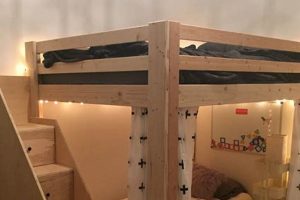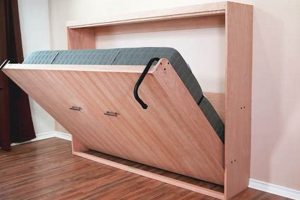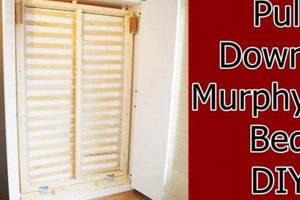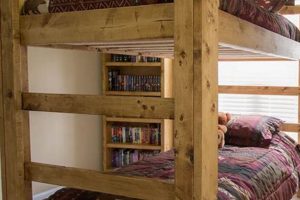A sleeping platform constructed at ground level, often using readily available or repurposed materials, provides an alternative to traditional bed frames. This type of bed often involves a mattress placed directly on the floor or a low platform. For example, individuals might use wooden pallets or build a simple frame from lumber to elevate the mattress slightly, achieving a similar aesthetic and function.
Opting for this arrangement offers several potential advantages, including cost savings, simplified construction, and space efficiency, particularly in smaller living areas. Historically, floor sleeping has been a common practice in many cultures, reflecting diverse approaches to comfort and resource management. The current resurgence of this style aligns with minimalist design trends and a focus on practical, unfussy home furnishings.
The following sections will explore material choices for such projects, construction techniques appropriate for various skill levels, and considerations for hygiene and mattress care when implementing this type of sleeping arrangement. Specific design ideas and potential challenges will also be addressed to provide a comprehensive understanding of creating a customized sleeping space.
Practical Recommendations
The following recommendations are designed to optimize the creation and maintenance of a ground-level sleeping arrangement. Adherence to these tips can enhance comfort, durability, and overall satisfaction with the project.
Tip 1: Material Selection. Choose materials resistant to moisture and pests. Kiln-dried lumber or treated pallets are preferable for platform construction. Consider using a vapor barrier between the floor and any wood components to prevent moisture wicking.
Tip 2: Ventilation is Crucial. Ensure adequate airflow beneath the mattress. A slatted platform design allows for better air circulation than a solid surface. This reduces the risk of mold and mildew growth.
Tip 3: Mattress Considerations. Select a mattress appropriate for floor placement. Memory foam mattresses, which tend to trap moisture, may require more frequent airing. Spring mattresses may benefit from a solid platform base for support.
Tip 4: Regular Maintenance. Routinely inspect the area under the mattress for moisture or signs of pests. Vacuum the floor and the underside of the mattress regularly to remove dust and allergens.
Tip 5: Platform Stability. If constructing a platform, ensure it is structurally sound and capable of supporting the weight of the mattress and occupants. Use appropriate fasteners and consider reinforcing corners for added stability.
Tip 6: Edge Treatment. If using pallets or unfinished lumber, sand down any rough edges or splinters to prevent injury. Consider applying a sealant or varnish to protect the wood and enhance its appearance.
Tip 7: Consider Room Size. Account for the overall dimensions of the space when designing the sleeping area. A low profile can create the illusion of more space, but ensure there is sufficient room for comfortable movement.
Implementing these suggestions can contribute to a comfortable, hygienic, and durable sleeping environment, maximizing the benefits of this simplified approach to bedroom furnishing.
The subsequent section will delve into potential aesthetic considerations and design variations for achieving a personalized and visually appealing sleeping space.
1. Material Selection
Material selection is a critical determinant of the success and longevity of a ground-level sleeping platform. The choice of materials directly impacts structural integrity, resistance to environmental factors, and overall comfort. For example, using untreated lumber in a humid environment will inevitably lead to moisture absorption, promoting mold growth and structural decay. Conversely, selecting kiln-dried or treated lumber provides enhanced resistance to moisture, extending the lifespan of the platform. The type of fastener employedscrews versus nailsalso influences the platform’s stability and load-bearing capacity.
The correlation between material choice and hygiene is equally significant. Porous materials like untreated wood can harbor dust mites and allergens, potentially compromising air quality. Smooth, non-porous surfaces, such as sealed wood or metal, facilitate easier cleaning and reduce the accumulation of allergens. The decision to use repurposed materials, such as wooden pallets, necessitates careful inspection for prior contamination or treatment with harmful chemicals. Failure to adequately assess and prepare repurposed materials can introduce health risks into the sleeping environment. Furthermore, material selection has a direct impact on the acoustic properties of the room. Solid platforms may transmit impact noise more readily than those constructed with sound-dampening materials.
Ultimately, the deliberate selection of appropriate materials is paramount in creating a safe, durable, and comfortable ground-level sleeping area. Ignoring these considerations can result in structural failures, health hazards, and reduced long-term cost-effectiveness. Prioritizing material quality and suitability is an investment in the sleeping platform’s sustainability and the occupant’s well-being. In sum, informed material choice is essential when undertaking this home project.
2. Ventilation Design
Effective ventilation is a paramount consideration in the design and construction of a ground-level sleeping platform. Insufficient airflow beneath the mattress creates an environment conducive to moisture accumulation, potentially leading to mold growth, bacterial proliferation, and mattress degradation. The design of the platform, therefore, must actively promote air circulation to mitigate these risks.
- Slatted Platform Construction
A platform constructed with spaced slats allows for air to circulate freely beneath the mattress. The spacing between the slats should be sufficient to permit airflow while still providing adequate support for the mattress. Inadequate spacing restricts airflow, negating the benefits of the slatted design. Common examples include using wood or metal slats with gaps ranging from one to three inches. The specific spacing depends on the mattress type and weight distribution.
- Elevation from the Floor
Even a minimal elevation of the platform above the floor surface significantly improves ventilation. Raising the platform by a few inches creates a space for air to circulate underneath, preventing direct contact between the mattress and the floor, which can be a source of moisture. This elevation can be achieved using legs, blocks, or a low frame. The impact of this elevation is noticeable in damp climates, where ground moisture is more prevalent. Without elevation, the mattress acts as a sponge, absorbing moisture from the floor.
- Material Permeability
The materials used in the platform’s construction can also influence ventilation. Certain materials, like breathable fabrics or open-cell foam, promote air circulation, whereas impermeable materials, such as plastic sheeting, can impede airflow. Choosing materials with inherent breathability enhances the overall ventilation of the sleeping arrangement. An example of effective design is using a frame built of breathable wood, such as pine or cedar.
The interrelationship between these facets highlights the critical role of intentional ventilation design in maintaining a hygienic and comfortable sleeping environment. Neglecting these considerations can lead to adverse health outcomes and premature mattress degradation. As such, integrating effective ventilation strategies is a core requirement for this type of bed project.
3. Mattress suitability
Mattress suitability is a critical determinant of the overall success of this type of bed project. A mismatch between the chosen mattress and the floor-level placement can lead to compromised comfort, reduced mattress lifespan, and potential health concerns. The close proximity to the floor exposes the mattress to moisture and dust, necessitating careful consideration of mattress type and material. For example, a memory foam mattress, known for its moisture-retentive properties, may develop mold or mildew when placed directly on the floor without adequate ventilation, leading to respiratory issues or skin irritation for the occupant. Conversely, an innerspring mattress, while more breathable, may require a solid platform base to prevent sagging and maintain structural integrity when used in this arrangement.
The thickness and density of the mattress also impact the comfort and support provided. A thin mattress placed on a hard floor surface may not provide adequate cushioning, resulting in pressure points and discomfort. Thicker mattresses, particularly those with multiple layers of foam or padding, can offer improved comfort, but may also exacerbate moisture retention issues if not properly ventilated. The size of the mattress relative to the available floor space must also be considered. An oversized mattress may impede movement around the room, while an undersized mattress may create an aesthetically unappealing and functionally awkward sleeping space. Furthermore, the mattress’s fire retardancy should meet safety standards, regardless of its placement.
In conclusion, selecting a suitable mattress is an indispensable component of a successful ground-level sleeping arrangement. Careful consideration of material breathability, thickness, density, size, and safety standards is essential to ensure comfort, hygiene, and longevity. Ignoring these factors can undermine the benefits of this project and potentially lead to negative health outcomes. Practical solutions, such as using a slatted platform, incorporating a moisture barrier, and regularly airing the mattress, can mitigate some of the inherent challenges associated with this sleeping arrangement.
4. Structural Integrity
Structural integrity is paramount in any “diy bed on the floor” project. The absence of a conventional bed frame necessitates that the foundational structure, whether a platform or direct-to-floor arrangement, bears the entire load of the mattress and occupants. Failure to adequately address structural considerations can result in collapse, instability, and potential injury. For example, a pallet-based platform constructed with damaged or weakened pallets may buckle under the combined weight, creating an unsafe sleeping environment. Similarly, a frame built from insufficient lumber dimensions may exhibit excessive flex, leading to premature mattress wear and discomfort.
The specific requirements for structural integrity depend on several factors, including the dimensions of the sleeping surface, the weight capacity needed, and the materials used in construction. Platforms intended for multiple occupants or heavier mattresses necessitate more robust support structures. The choice of fasteners, such as screws versus nails, also influences the overall strength and stability of the assembly. Furthermore, the design should account for potential stress points, such as corners and joints, which are more susceptible to failure under load. A real-world illustration involves reinforcing corners with metal brackets or employing joinery techniques, such as mortise and tenon, to enhance structural resilience. Ignoring these details can have a domino effect leading to gradual degradation.
In summary, the structural integrity of a “diy bed on the floor” is non-negotiable. It directly impacts safety, durability, and long-term user satisfaction. Meticulous planning, selection of appropriate materials, and sound construction techniques are essential to ensuring a stable and secure sleeping platform. Ignoring structural considerations can lead to potentially hazardous outcomes and undermine the cost-saving and space-efficient benefits that such a project aims to deliver.
5. Hygienic maintenance
Hygienic maintenance is not merely an ancillary consideration but a fundamental requirement for ground-level sleeping arrangements. The inherent proximity to the floor exposes mattresses and bedding to increased levels of dust, allergens, and potential moisture accumulation, necessitating diligent and proactive cleaning practices to mitigate health risks and ensure long-term comfort.
- Regular Vacuuming
Vacuuming the floor beneath the mattress and the mattress surface itself on a regular basis is crucial. This removes dust mites, pet dander, and other allergens that can accumulate in this environment. A vacuum cleaner with a HEPA filter is recommended to capture fine particles effectively. Frequency should be at least weekly, and more often in households with pets or individuals with allergies. An example, failure to vacuum regularly will lead to dust accumulation, fostering allergens that would negatively impact sleeping quality.
- Mattress Rotation and Flipping
Rotating and flipping the mattress periodically helps to distribute wear evenly and prevent the formation of indentations. This practice also allows for better ventilation of the underside of the mattress, reducing moisture buildup. Rotation should occur at least every three months, and flipping (if the mattress is designed to be flipped) should be done on the same schedule. Regular rotation will extend the life of the mattress.
- Addressing Moisture Concerns
Ground-level sleeping arrangements are particularly susceptible to moisture accumulation. Using a mattress protector, especially one that is waterproof and breathable, is essential to prevent moisture from seeping into the mattress. In addition, ensuring adequate ventilation under the mattress, such as through a slatted platform, helps to reduce moisture buildup. A dehumidifier might also be beneficial in damp climates, will reduce the chances of moisture buildup.
- Periodic Deep Cleaning
In addition to regular vacuuming and rotation, periodic deep cleaning of the mattress is recommended. This can involve steam cleaning or using a specialized mattress cleaning solution to remove stains and eliminate odors. Ensure that the mattress is thoroughly dried after cleaning to prevent mold growth. An appropriate cleaning solution would kill dust mites.
The integration of these hygienic maintenance practices is not optional but imperative for ensuring the long-term viability and health benefits of ground-level sleeping arrangements. Neglecting these measures can lead to a compromised sleeping environment, increased allergen exposure, and a reduced lifespan for the mattress. Through consistent attention to cleanliness and moisture control, the potential drawbacks can be effectively mitigated.
6. Space optimization
Space optimization is a central consideration when implementing a ground-level sleeping arrangement. The decision to forgo a traditional bed frame directly impacts the perceived and actual usable area within a room. Efficiently maximizing available space through strategic design choices is, therefore, crucial to realizing the full potential of this project.
- Vertical Space Utilization
Eliminating a conventional bed frame often frees up vertical space that can be repurposed for storage or decorative elements. Shelving units, wall-mounted cabinets, or tall plants can be strategically placed above the sleeping area to enhance storage capacity or add visual interest without encroaching on floor space. An example would be installing floating shelves above the head of the sleeping platform to store books or personal items, thus maintaining a sense of openness while maximizing storage potential. This is particularly relevant in compact living spaces where every square foot is valuable.
- Multi-Functional Design
Integrating multi-functional elements into the sleeping platform’s design can further optimize space utilization. A platform with built-in drawers or storage compartments beneath the mattress provides discreet and accessible storage for clothing, bedding, or other personal items. A low platform can double as a seating area during the day, transforming the sleeping area into a more versatile living space. Multi-functional designs maximize the room’s usability.
- Minimalist Aesthetic
A ground-level sleeping arrangement inherently lends itself to a minimalist aesthetic, which can contribute to a sense of spaciousness and order. Reducing clutter and unnecessary furniture pieces can further enhance the feeling of openness. Choosing light colors for walls and bedding can also amplify the effect of space. The minimalist design approach declutters the bedroom.
- Strategic Placement
The placement of the sleeping platform within the room significantly impacts space optimization. Positioning the platform against a wall or in a corner can free up valuable floor space in the center of the room. Aligning the platform with the room’s architectural features, such as windows or doorways, can also enhance the sense of flow and spaciousness. For example, placing this sleeping platform in a smaller, less used room would maximize a household’s square footage and available living space.
The principles of space optimization are inextricably linked to the successful implementation of this bed project. By strategically leveraging vertical space, incorporating multi-functional elements, embracing a minimalist aesthetic, and carefully considering placement, it becomes possible to transform a sleeping area into a more functional, spacious, and aesthetically pleasing environment. Neglecting these considerations can negate the potential space-saving benefits and result in a cramped or cluttered living space.
Frequently Asked Questions
This section addresses common inquiries and misconceptions surrounding the adoption of ground-level sleeping arrangements. The information provided aims to offer clarity and inform decision-making.
Question 1: Is a ground-level sleeping arrangement less hygienic than a traditional bed?
The proximity to the floor increases exposure to dust and allergens. However, with diligent cleaning practices, including regular vacuuming and mattress maintenance, hygiene can be maintained. Neglecting cleanliness will undoubtedly lead to a less sanitary environment.
Question 2: What mattress type is most suitable for floor placement?
Breathable materials, such as innerspring or latex, are generally preferred over memory foam, which tends to trap moisture. A slatted platform is recommended to promote airflow regardless of mattress type. Mattress selection should always consider ventilation factors.
Question 3: Does sleeping on the floor pose any health risks?
Individuals with pre-existing respiratory conditions or allergies may experience increased symptoms due to the higher concentration of allergens near the floor. Proper ventilation and cleaning are crucial. Medical advice is recommended for those with health concerns.
Question 4: How can mold growth be prevented in a ground-level sleeping arrangement?
Adequate ventilation is essential. A slatted platform design, combined with regular mattress airing, minimizes moisture accumulation. Using a moisture-wicking mattress protector is also recommended. Moisture management is the key.
Question 5: What are the advantages of a ground-level sleeping arrangement?
Potential benefits include cost savings, space efficiency, and a minimalist aesthetic. The absence of a bed frame can create a sense of openness in smaller spaces. These advantages are primarily aesthetic and spatial.
Question 6: How does a floor-level arrangement impact the lifespan of a mattress?
Without adequate ventilation, a mattress placed directly on the floor may degrade more quickly due to moisture accumulation and compression. Proper maintenance and platform design are essential to maximize mattress longevity. The platform extends the lifespan of the mattress.
In summary, successful implementation of this sleeping arrangement hinges on proactive hygiene practices and careful consideration of material choices.
The subsequent section will provide a concluding overview of the key considerations discussed, reinforcing the importance of informed decision-making in creating a comfortable and safe sleeping environment.
DIY Bed on the Floor
The preceding exploration of “diy bed on the floor” arrangements underscores the critical interplay between design choices, material selection, and ongoing maintenance. Successfully implementing such a project necessitates careful consideration of ventilation, structural integrity, and hygiene. While offering potential benefits in cost savings and space efficiency, ground-level sleeping arrangements demand a proactive approach to mitigate inherent risks associated with moisture accumulation and allergen exposure.
Ultimately, the decision to pursue a “diy bed on the floor” project should be predicated on a thorough understanding of its implications and a commitment to rigorous maintenance practices. The information provided serves as a foundation for informed decision-making, empowering individuals to create a comfortable and safe sleeping environment tailored to their specific needs and circumstances. Continued vigilance regarding hygiene and structural stability remains paramount for long-term satisfaction and well-being.







